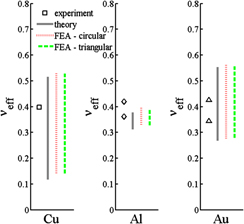Article contents
Effective Poisson’s ratio from combined normal and lateral contacts of single crystals
Published online by Cambridge University Press: 26 October 2011
Abstract

When an elastic half-space is subjected to both normal and tangential contact, the ratio of normal and tangential contact stiffnesses can be measured by various scanning force microscopy techniques. For elastically isotropic solids, this stiffness ratio depends on Poisson’s ratio as given by the Mindlin solution. An anisotropic elastic contact analysis here shows the difference between the effective Poisson’s ratio as defined from the stiffness ratio and its uniaxial counterpart with respect to various crystal structures and various normal/tangential contact directions. Closed-form analytical solutions of effective indentation moduli are derived for materials with at least one plane of transverse isotropy. Since the Sneddon (normal contact) and Mindlin (lateral contact) solutions are derived under different frictional conditions, finite element simulations were performed which show that the effects of elastic dissimilarity and contact shape are generally small but not negligible. The predicted dependence on crystallographic orientation and elastic anisotropy has been compared favorably with previously reported multiaxial contact experiments for a number of cubic single crystals. Implications for atomic force microscopy based experiments are also discussed.
Keywords
- Type
- Articles
- Information
- Journal of Materials Research , Volume 27 , Issue 1: Focus Issue: Instrumented Indentation , 14 January 2012 , pp. 182 - 191
- Copyright
- Copyright © Materials Research Society 2011
References
REFERENCES
- 6
- Cited by




